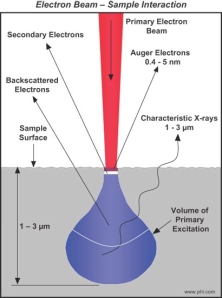Probably the most important concept to get across when considering an analytical technique is the analysis depth. Some techniques, such as Auger Electron Spectroscopy (AES), X-ray Photoelectron Spectroscopy (XPS), and Secondary Ion Mass Spectrometry (SIMS), analyze just the top atomic layer or 10 nm of material. This can be very important for contamination issues or surface passivation, for example, where the important layer is hundreds of angstroms thick. These surface segregated layers would be very difficult if not impossible to detect with a deeper analysis volume, like with Scanning Electron Microscopy with Energy Dispersive X-ray Spectroscopy (SEM/EDS) that has a depth of x-ray generation of about one micron. Conversely, if the bulk material is more important then the deeper analysis volume would be more appropriate as the more surface sensitive techniques would only detect the outer carbon or oxide layer, for example. Even at a micron, SEM/EDS is still considered a surface technique and would not be appropriate for an accurate bulk analysis. Techniques for bulk alloy analysis would be spark Optical Emission Spectroscopy (OES) and/or ICP.
It’s also important to understand that analysis depth is not the same as beam size or imaging resolution. With SEM/EDS the beam size and resolution can be very small (down to the nm range) but the x-rays are still being generated from a much larger volume. The opposite can be true of AES and XPS where the beam size can range from 5-500 microns (field emission AES has a much better resolution) yet the analysis volume is still only about 10 nm.
These are all important concepts to keep in mind when interpreting data. It’s easy to try to read variations in composition in depth profiles, line scans, and maps but if the variation scale is close to or less than the analysis volume it’s not reliable.
